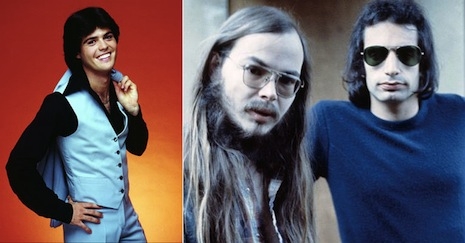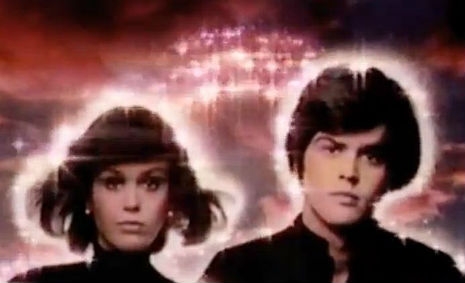Conversely, I grew up thinking of Steely Dan as my mom’s lame-o jazz-rock “mellow gold” relics. But at some point I listened to Aja on a whim of childhood sentiment and found myself really enjoying it. You might say, I had a change of heart. (Sorry, I had to do that.)
And yet, here I am, laughing my ass off at an open letter from Walter Becker and Donald Fagen, posted from their very own website in 2006. The pair start off with some heavy-handed praise, then transition to a brilliant back-handed concern-troll; they were of the opinion he had lost his touch. Honestly, it’s a little difficult to tell if they’re being sarcastic or earnest—right up until the point that they offer to save Anderson’s career with some custom-written Steely Dan originals for the low price of $400,000.
From: W. Becker and D. Fagen [AKA Steely Dan© ]
To: Wes Anderson
Maestro:
As you may know, we are the founders of the celebrated rock band “Steely Dan”©. If for some reason you don’t know our work, check with Owen and Luke Wilson - they’re both big fans. Here’s something you may not know about us: when not distracted by our “day job” – composing, recording, touring and so forth – we like to head downstairs into the paneled basement of our minds and assume the roles we were born to play - you may have already guessed it by now – the roles of Obsessive Fans of World Cinema.
That’s right. Eisenstein, Renoir, Rene Clair, Bunuel, Kurosawa, Fellini, Godard, Tarkovsky, Ophuls the Elder, Blake Edwards, Ophuls the Younger, you name it. Sat there, dug it.
Maestro, we give to you this Message: there was a time when Giants walked among us. And, damn, if you, Wes Anderson, might not be the one to restore their racial dominance on this, our planet, this Terra, this… Earth.
You may have heard that we have recently made it our personal project and goal to deliver a certain actor of no small importance to your past and present work from a downward spiral of moral turpitude from which it seemed there might be no escape. We are delighted to report that, with the news of Mr. ________’s participation in your new film (which we understand to be entitled, indeed, charmingly, “Darjeeling Limited”), our efforts have been repaid, and How.
This unqualified victory has inspired us to address a more serious matter. Let’s put our cards on the table - surely, we are not the first to tell you that your career is suffering from a malaise. Fortunately, inasmuch as it is a malaise distinctly different than that of Mr.______ , and to the extent that you have not become so completely alienated from the intellectual and moral wellsprings of your own creativity, we are hoping that we - yours truly, Donald and Walter - may successfully “intervene” at this point in time and be of some use to you in your latest, and, potentially, greatest, endeavor.
Again, an artist of your stripe could never be guilty of the same sort of willing harlotry that befalls so many bright young men who take their aspirations to Hollywood and their talent for granted. You have failed or threatened to fail in a far more interesting and morally uncompromised way (assuming for a moment that self-imitation and a modality dangerously close to mawkishness are not moral failings, but rather symptoms of a profound sickness of the soul.)
Let’s begin with a quick review of your career so far, as it is known to us and your fans and wellwishers in general.
You began, spectacularly enough, with the excellent “Bottle Rocket”, a film we consider to be your finest work to date. No doubt others would agree that the striking originality of your premise and vision was most effective in this seminal work. Subsequent films - “Rushmore”, “The Royal Tenenbaums”, “The Life Aquatic” - have been good fun but somewhat disappointing - perhaps increasingly so. These follow-ups have all concerned themselves with the theme we like to call “the enervated family of origin”©, from which springs diverse subplots also largely concerned with the failure to fulfill early promise. Again, each film increasingly relies on eccentric visual detail, period wardrobe, idiosyncratic and overwrought set design, and music supervision that leans heavily on somewhat obscure 60’s “British Invasion” tracks a-jangle with twelve-string guitars, harpsichords and mandolins. The company of players, while excellent, retains pretty much the same tone and function from film to film. Indeed, you must be aware that your career as an auteur is mirrored in the lives of your beloved characters as they struggle in vain to duplicate early glories.
But, look, Mr. Anderson, we’re not trying to be critical – dammit - we just want to help.
Enter the Faboriginals©, Donald Fagen and Walter Becker of Steely Dan©. The muse is a fickle mistress at best, and to leave her high and dry, with just a “lick and a promise” of the greatness of which one is capable - well, sir, it’s just plain wrong. It is an Art Crime© of the first magnitude and a great sin against your talent and your Self. We just don’t want to see it go down that way.
So the question, Mr. Anderson, remains: what is to be done? As we have done with previous clients, we have taken the liberty of creating two alternative strategies that we believe will insure success - in this case, success for you and your little company of players. Each of us – Donald and Walter - has composed a TITLE SONG which could serve as a powerful organizing element and a rallying cry for you and Owen and Jason and the others, lest you lose your way and fall into the same old traps.
STRATEGY 1:
Donald believes that you are at a crossroads and that you must do what none of your characters has been able to do - namely, let go of the past: leave it as it lies with no concern for the wreckage, and move boldly forward towards new challenges and goals. To this end he has composed a fresh, exciting title song for your new film, “Darjeeling Limited”. It’s rousing, it’s hip, by turns, funny and sad, and then funny again. Although the music is not entirely out of line with the chic “retro” pop you seem to favor, it’s been fire-mopped© clean of every last trace of irony and then re-ironized at a whole new level – “post-post-post-modern” if you will. The lyrics are as follows:
[CHORUS ]
Darjeeling Limited©
That’s the train I wanna get kissed on
Darjeeling Limited©
But I’ll be lucky if I don’t get pissed on
This is a country of starving millions
We’ve got to get ‘em their tea on time
I know romance should be on the back burner
But girl I just can’t get you off my mind
Cause baby every single time I’m with you
I’d like to have as many arms as Vishnu
(Arms as Vishnu)
[CHORUS ]
Darjeeling Limited©
That’s the train I wanna get kissed on
Darjeeling Limited©
But I’ll be lucky if I don’t get pissed on
You told me you’d be mine forever
That we’d get married in the Taj Mahal
The minute I’m done baggin’ this tea, babe
Then I’ll be makin’ you my Bollywood doll
Forget the Super Chief, the China Star now
Give me the choo-choo with the Chutney Bar now
(Chutney Bar now)
[CHORUS ]
Darjeeling Limited©
That’s the train I wanna get kissed on
Darjeeling Limited©
But I’ll be lucky if I don’t get pissed on
STRATEGY 2:
Walter believes that the best strategy for you now would be to return to the point in your career when it was all good, when all was working as it should, when there was magic in every song you sung, so to speak. Youthful idealism, jouissance©, original spirit - these will be your watchwords. “Birth is residual if it is not symbolically revisited through initiation” - it’s an old French proverb. In other words, your new film will be called “Bottle Rocket Two©” and will be the logical continuation of the first film which was so well loved. (“Bottle Rocket” was our fave among your movies, did we mention that?) You pick up where you left off and find a new continuation that takes you elsewhere than to ruin. The eponymous title song would reframe the important existential questions which are at the core of your artistic vision and would go something like this:
Bottlerocket Two©
Any resemblance
Real or imagined
People or places
Living or dead
Any resemblance
As-if or actual
Characters or circumstance
It’s all in your head
Flying out to India
Trying to get into you
Old Bombay
It’s a very long way
To chase a “bottlerocket” to©
Precise simulations
Possible parallels
Never intended
Co-incidentals
Persons and places
Present or otherwise
Comrades in comedy
Brothers in crime
Hiding out in India
Babycakes they’re watching you
This is our latest -
It may be our greatest -
It’s called “bottlerocket” too©!
Who pitched the story?
Who built the scenery?
Who raised the money?
Whose movie is it,
Anyway?
[Guitar Solo ]
Come to think about it, these songs are both so fucking strong that you may wish to consider a hybrid approach that uses both of them - after all, they’re both set in India, which is where your company is setting up shop now. You could go with some kind of “film within a film” or even a “film within a film within a film” or some such pomo horseshit, just like Godard’s “King Lear” or whatever. That’s your call, you’re the director.
Please note that all these lyrics and titles have been heavily copywritten, trademarked, registered, patented, etc., etc., so anybody using them will have to negotiate the rights from the legitimate Faboriginal© owners, which is us. We are currently represented by Michael “Mickey” Shaheen, Esq., of Howard Beach, Queens County, New York NY.
The other change that we would have to make would concern Mark Mothersbaugh. Everyone in Hollywood knows that he is a first class professional musical supervisor. Obviously you and he have a lot of great history together and we can imagine there is a certain rapport both professional and personal. But we certainly can’t work with him, anymore than he would consent to work with us. Same thing for the mandolins and the twelve-string stuff and the harpsichord, they’re out. You yourself may be partial to those particular instruments. We’re not. Remember, we saw “Tom Jones” in its original theatrical release when we were still in high school, we had to listen to “Walk Away Renee” all through college and we fucking opened for Roger McGuinn in the seventies, so all that “jingle-jangle morning” shit is no big thrill for us, OK?
Argh!...goddammit…sorry, guy! We kinda lost it for a minute there. Look - Mark is probably a swell guy. But you, Wes Anderson, must remember that Mark and his music are part of the old way of doing things, the old way of being, the old way that has brought you to the precipice. Mr. Anderson, you must be fearless in defense of your creations and your genius, absolutely fearless, and not give in to sentimental considerations.
So - let’s get going, shall we? Send the check for US$400,000 (advance on licensing fees) out by Fedex to Mickey by tomorrow and we’ll talk a little later in the day about merch, percentages, backend, soundtrack, ASCAP, etc. Mickey himself doesn’t need any kind of an advance but he’ll probably take a couple of points on your net career action. It’s a little expensive - and Mickey certainly doesn’t need the bread - but just pay the points, okay? It’s a lot better than the alternative.
We remain your abject servants,
W. Becker and D. Fagen AKA Steely Dan©























